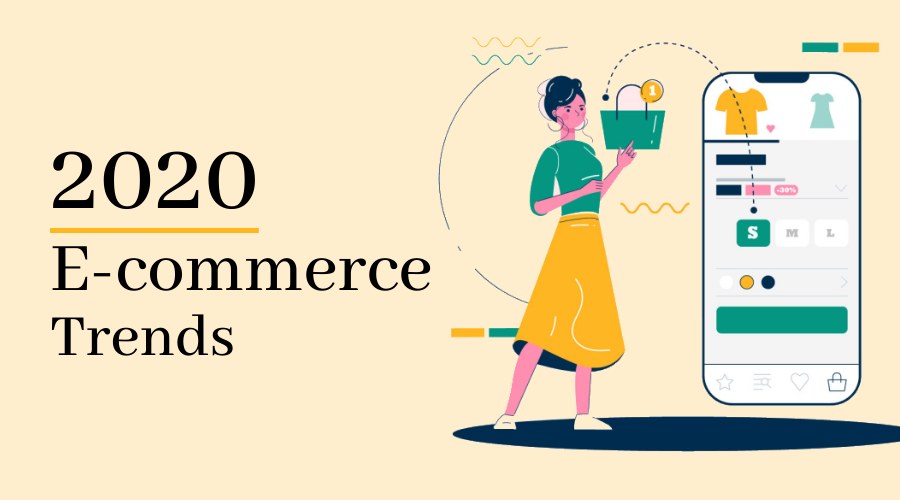Retailers should constantly stay updated with the latest e-commerce trends to gain maximum customers. In this blog, we’ll be exploring all the emerging e-commerce trends in 2020 to deliver a great shopping experience.
With over 1.8 billion people purchasing products online globally. Moreover, as per the US Census Bureau, e-commerce sales in the US alone accounted for over 11% of all retail sales in 2019. Such trends show that the demand for the e-commerce market is steadily growing and will continue to boom in 2020 with no looking back.
With so many options available like Shopify, Magento, WooCommerce, OpenCart, and others for e-commerce platforms that help establish a successful online retail business, e-commerce has been satisfying the dynamic needs of customers with constantly advanced features and evolving trends.
What Is the Future of E-Commerce?
The e-commerce industry notices changes every year, but irrespective of its ups and downs, the rise of the e-commerce market is invincible. With the increasing demand for e-commerce sites, the demand for skilled e-commerce developers is also growing as businesses are looking forward to establishing an online store and cannot compromise with the quality.
Per Statista, from $3.53 trillion in 2019 to $6.54 trillion in 2022, the future of e-commerce in 2020 is clearly upward with no signs of decline.
Top 7 Significant E-Commerce Trends to Look for in 2022
If you want to give your customers exactly what they want, keep up with the latest trends in the e-commerce industry. Here, we’ve handpicked some demanding and highly-adopted e-commerce trends that will rock in 2020.
1 – Enhance Online Shopping with AR
Augmented Reality (AR) has significantly changed the way today’s people experience online shopping. AR lets customers visualize the products (clothes, appliances, groceries, and more) so that they can decide whether to take the product or not before purchasing.
According to ThinkMobiles, 63% of customers say AR has improved their shopping experience, and 35% say that AR would make them shop online more often. E-commerce giants have already adopted this emerging technology. What are you waiting for?
2 – Growing Demand for Voice Commerce
Voice assistants like Google Assistant, Siri, and Alexa are growing popular day-by-day. Loup Ventures says 75% of Americans will have smart speakers by 2025. It is believed that voice shopping is set to jump to $40 billion by 2022 from $2 today.
Voice shopping is automatic, hands-free, and, most importantly, convenient. It allows customers to make purchases with a simple voice command with no browsing and entering payment details, thus saving customers’ time.
3 – Improved Experience with AI and ML
Irrespective of niche, Artificial Intelligence (AI) and Machine Learning (ML) are widely adopted by businesses. AI and ML are one of the emerging trends in e-commerce that help businesses learn about their customers and provide them with the automated and personalized experiences they want.
Being the hottest trends in e-commerce, AI and ML are giving online store owners the weapon to attract more customers, which will grow stronger in 2020.
4 – Mobile Shopping Is Growing
As per Statista, 73% of e-commerce sales will take place on a mobile device by the end of 2021. This tells that mobile commerce is on a constant rise; thus, it becomes critical to developing an e-commerce store based on the mobile-first concept.
An e-commerce business owner should optimize apps and make the website mobile-friendly so that their customers receive the best mobile shopping experience possible ever.
5 – Personalization Is the Future
Creating a personalized experience online results in revenue-boosting by 10% because it straight away connects your customers to the brand. But, what is e-commerce personalization? E-commerce personalization is creating shopping experiences that catalyze specific customers. It is believed that over 80% of customers are more likely to buy from an online store that gives personalized experiences.
6 – Conversion Optimization
E-commerce has a highly competitive market; thus, e-commerce optimization can be an effective solution that can guarantee you a boost in revenue. Doing this rightly can build trust among customers, offer a better experience, make your website stand out from the competitors, and lead you to have higher conversions.
7 – Innovation with Headless and API
Among all, Headless and API are among the growing trends in e-commerce that customers interact with directly. Headless commerce allows a store e-commerce platform to use a CMS, DXP, PWA, and more to complete a tech stack. The year 2020 is going to an increased selection of headless, like more IoT and PWAs.
Final Thought
Trends come and go, but to stay ahead of the competitors, a business needs to be attentive about the latest e-commerce trends. All the mentioned-above e-commerce trends will lead you towards improved shopping experience, retained customers, increased conversions, and maximize ROI. So are you ready to reap the benefits of these trends?











